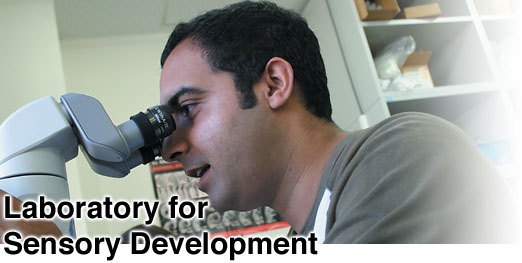




     |

Organogenesis is a monumental undertaking. From situating a given organ at its correct location, to confirming that it is correctly engineered and constructed, to ensuring the necessary functional connections with other organs, the embryo has a daunting task before it; indeed, perhaps we should be surprised that the result is so frequently successful. Taking sensory organogenesis as our model system, we hope to be able to follow the route an organ takes in its development, and seek to understand the steps that allow it to reach maturity. One aim is to be able to recapitulate these steps in vitro, with the ultimate goal of providing potentially clinically relevant applications.
The ear provides a particularly rich system for study. The inner ear, which converts mechanical stimulation to electrical impulses, is formed from a piece of tissue originally destined to become skin; a fate altered by instructive signals in a process known as induction. In our research to date, we have identified the mechanism and the signals that set this early tissue on its path toward an inner ear fate as well as those that determine its position. We next hope to learn how these signals are themselves established. We are also investigating the role these signals play in the regulated differentiation of the otic placode, and in better understanding the cellular, molecular and embryological process responsible for this elegantly engineered organ of hearing.
The inner ear cannot function alone. In higher vertebrates, it requires the middle ear to transduce sound that has been channeled through the external ear, as well as specialized regions within the brain to interpret the information it sends. But how is this intricate integration achieved? Using a combination of molecular and embryological techniques, we are characterizing the systems the embryo uses in the coordinated construction of the auditory apparatus.
We believe that an understanding of the embryological systems that control the development of the inner ear can be applied to the development of other organs, sensory organs in particular. By working to comprehend the induction and development of other sense organs, such as the olfactory system and the eye, we are now taking steps toward achieving insights into common mechanisms underpinning the development of organ systems.